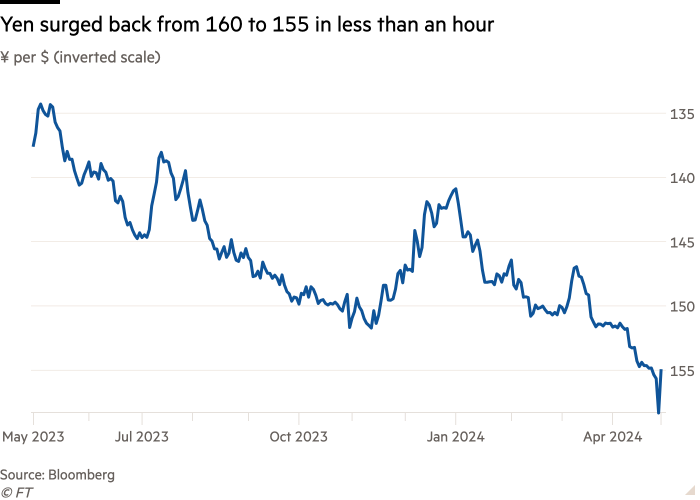Unlock the Editor’s Digest for free
Roula Khalaf, Editor of the FT, selects her favourite stories in this weekly newsletter.
The yen strengthened sharply against the dollar on Monday, rebounding from a 34-year low reached a few hours earlier in a move that traders said bore all the signs of an intervention by the Japanese authorities.
From about 1pm Tokyo time, the yen began to strengthen from ¥159.5 a dollar to ¥155.2 over a 50-minute period. Traders in Hong Kong, Australia and London said it was “highly likely” that the recovery was due to Japan’s finance ministry selling dollar reserves and purchasing the Japanese currency for the first time since late 2022.
Earlier in the day, the yen had fallen past ¥160 against the dollar, as the gulf between Japanese and US interest rates continued to pressure the currency. The yen’s slump accelerated after the Bank of Japan kept interest rates on hold near zero on Friday, with governor Kazuo Ueda offering no indication that he was concerned about the inflationary pressures stemming from a weak exchange rate.
Markets in Japan were closed on Monday for the first day of the country’s Golden Week holiday, giving Japanese authorities an opportunity to move the yen more easily in relatively light trading volumes, analysts said.
Multiple investors and analysts said the intervention appeared to have involved about $20bn to $35bn worth of yen purchases. They added that they assumed a breach of the ¥160 level had forced Japanese officials to act, though they did not have definitive evidence the intervention had taken place.
Japan’s top currency official Masato Kanda declined to comment on whether the Ministry of Finance had intervened on Monday. “It is hard to overlook the speculative, violent and abnormal moves [in the currency market] that are causing damage to economy,” he added, noting that authorities were ready to respond “24 hours, 365 days”.
Traders said the volatility of trading could have convinced some investors to unwind some of the huge bets they had amassed against the yen in recent weeks.

Tokyo had been warning for weeks that it was standing by to support the yen if trading became too volatile. Ueda said in mid-April that the central bank could act if the impact of the weak yen became “too big to ignore”.
The weaker yen has boosted inbound tourism and fuelled a surge in corporate profits earned overseas. But business leaders in recent weeks have called on the government to act since the currency’s decline has also raised living costs and hit domestic consumption.
The yen has lost about 11 per cent of its value against the dollar since the start of the year, hit by the prospect that the US Federal Reserve may need to keep borrowing costs higher for longer to tame inflation.
The “yen carry” trade, in which investors cheaply borrow the yen to fund investments in higher-yielding assets, is unlikely to start diminishing meaningfully until the Fed starts cutting rates, said Shusuke Yamada, head of Japan foreign exchange and rates strategy at Bank of America.
Yamada said in a note that preventing the yen from weakening below ¥155 a dollar would require continuous interventions by Japanese authorities to buy time until the BoJ raised rates, a move that is now not expected for at least three months. He added that any intervention would need to be larger than the series of interventions Japan carried out in 2022, which totalled about $62bn.
Benjamin Shatil, JPMorgan’s senior economist for Japan, said if the Japanese authorities had intervened, the effect might be limited because investors would continue to exploit Japan’s low interest rates and use the yen as a funding currency.
“This is a busy week in terms of US policy and data, thus this is likely only the opening chapter of what may set up to be a very volatile few sessions for the yen,” he said.
On Monday, the yen also fell to a record low against the euro, falling below ¥171 for the first time since the adoption of a single currency in 1999.











